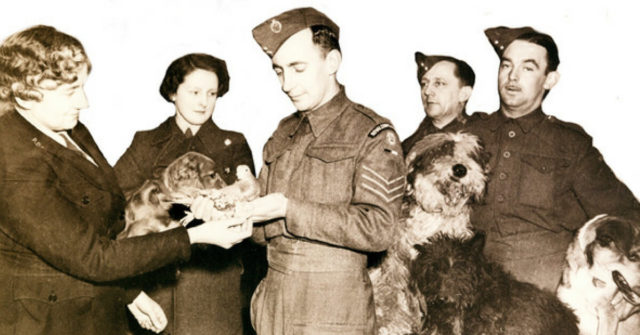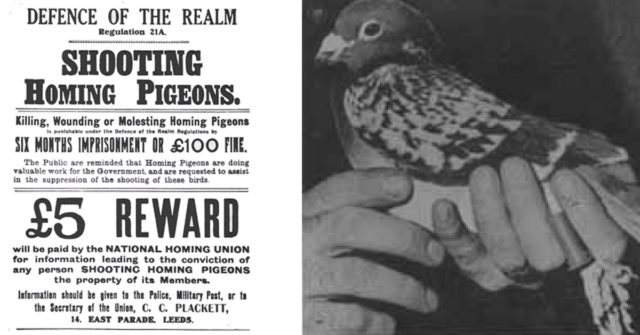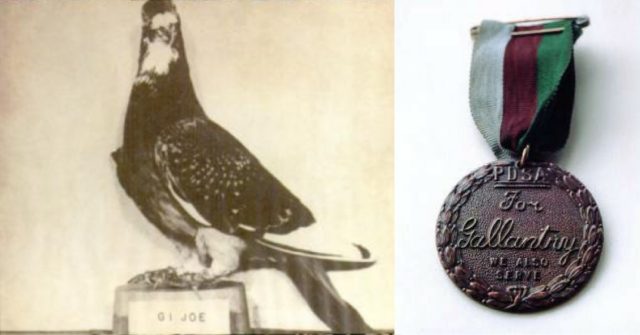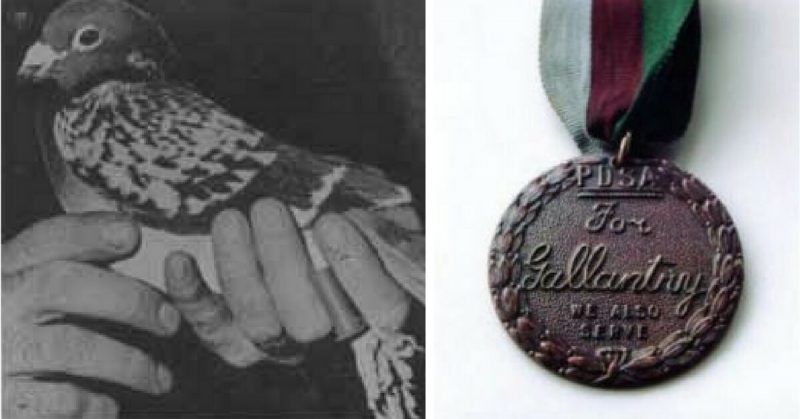Animals were part of war efforts throughout history. It would be hard to think of ancient and medieval warfare without horses, elephants, dogs, mules, and camels. Most of these animals held an important role as means of transport or assault. Many remained in service throughout the 20th century, and dogs remain in service to this day, as they help clear out the mines with their excellent sense of smell.
Among the animals used most frequently and for the longest period were pigeons, who served as messengers in many wars. Trusted for their speed, altitude, and homing ability, pigeons quickly became the main communication channel between armies, besieged towns or spies.
During WWII pigeons were still in use, both by the Allied and the Axis powers. At the outbreak of the war thousands of British pigeon owners donated their birds to the war effort. A volunteer organization was formed called the National Pigeon Service.
There were more than one million pigeons used by the army, the RAF and the Civil Defence Services including the police, the fire service, Home Guard and even Bletchley Park. All RAF bombers and reconnaissance aircraft were fitted with waterproof bird cages which carried pigeons. In a time that developed complex and cryptic ways of communication, the trained bird proved to be the most trustworthy carrier of important messages.
On 19th of August, 1942, the Allies launched an assault on the town of Dieppe, located on the northern coast of France. The attack was codenamed Operation Jubilee. The raid was the first attempt to reach the European soil after the retreat at Dunkirk. Even though the invasion proved to be a complete failure, it provided the desperately needed experience for all future landings conducted by the Allies throughout the Second World War.
At the same time, it was a moment of individual courage, as the plan of invasion fell apart. The operation was conducted mainly by Canadian troops together with their British and American counterparts. The bad weather conditions caused many landing crafts to miss their objective and disembark troops far from the designated beaches.

During Operation Jubilee, one Canadian pigeon, who served as a messenger proved to be invaluable. Designated as Pigeon NPS.41.NS.4230, but called Beachcomber by the troops, the bird was assigned to carry the first news of the raid from the soldiers who were part of the initial landing wave. This event marked the green light for the Dieppe Raid.
In this way, the commanders who were stationed on ships just off the coast of France were alerted and updated on the situation on the beach. Since it was a foggy morning on 19th of August, when the raid commenced, this sort of communication proved vital, as the Allied commanders had lost sight of the troops on the beaches.

Beachcomber carried a small container with a message, attached to his leg, and was sent alone. The usual practice was to send at least two pigeons with the same message, as the birds were vulnerable to gun fire. Also, the pigeons could stray from their path due to noise caused by shelling and fighting.
The Germans responded to the British use of messenger pigeons with marksmen and falconers. Falcons were trained to catch the pigeons and were rather successful with that. But Beachcomber didn’t stray, nor did he fall victim to German fire. He carried out his message, and doing so, possibly saved hundreds of lives. When a pigeon delivers his message, he flies in a small coop which possesses a mechanism attached to the bell. The bell serves just like a ringtone, notifying the person in charge that a message has been received.
Beachcomber continued to serve with the Canadian Army and received his Dickin Medal in 1944. The official statement for the award was: “For bringing the first news to this country of the landing at Dieppe, under hazardous conditions in September 1942, while serving with the Canadian Army.”

The Allies honored the animals that contributed to the war with this special medal that bore the name of Maria Dickin, who was a social reformer and an animal rights activist. She founded the People’s Dispensary for Sick Animals (PDSA) in 1917, and to honor her effort, the Dickin Medal was adopted during WWII. The medal is a bronze medallion, bearing the words “For Gallantry” and “We Also Serve” within a laurel wreath, carried on a ribbon of striped green, dark brown, and pale blue. Among other decorated pigeons during WWII were the British birds, Commando, Paddy, William of Orange, Mary of Exeter, Gustav, and the American, GI Joe.
There were only three medals given to animals who served in the Canadian Army during the Second World War. Besides from Beachcomber, two dogs were awarded the Dickin medal, a German Shepherd named Sam and a Newfoundlander called Gander. They were both involved in saving a soldier’s life.
Canada thanked the animals that served beside the men and women during WWII, by building a stone wall at the entrance to the Memorial Chamber in the Parliament Buildings in Ottawa. The wall is decorated with carved animals and the words “The Humble Beasts that Served and Died.”
